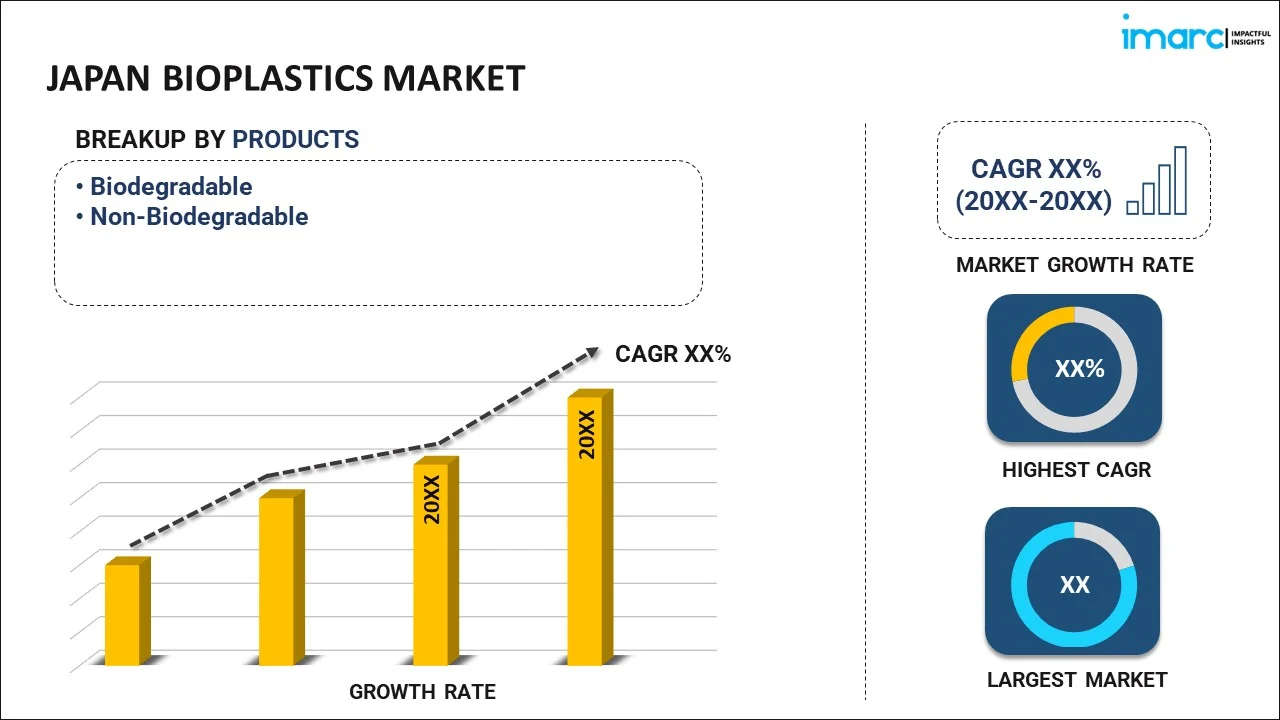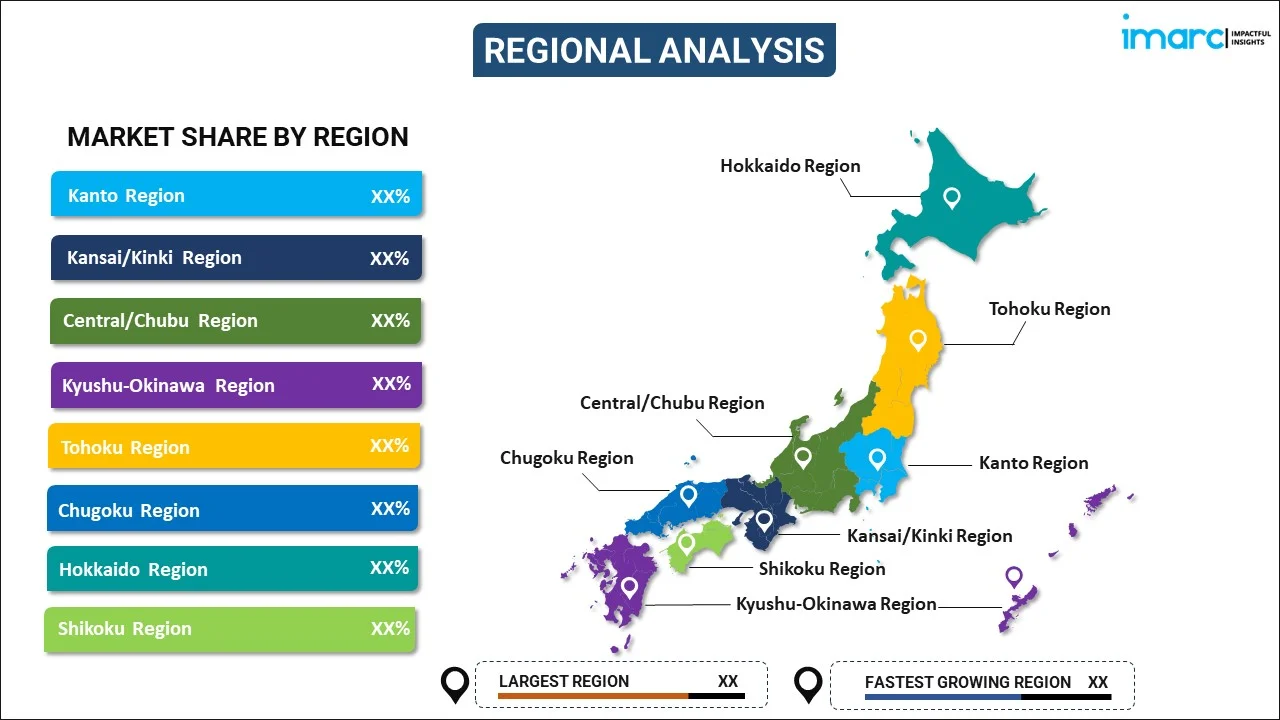
Japan Bioplastics Market Report by Product (Biodegradable, Non-Biodegradable), Application (Flexible Packaging, Rigid Packaging, Agriculture and Horticulture, Consumer Goods, Textile, Automotive and Transportation, and Others), Distribution Channel (Online, Offline), and Region 2025-2033
Market Overview:
Japan bioplastics market size reached USD 822.1 Million in 2024. Looking forward, IMARC Group expects the market to reach USD 2,405.7 Million by 2033, exhibiting a growth rate (CAGR) of 12.7% during 2025-2033. The increasing application of renewable resources such as plant-based feedstocks, which offer an alternative that reduces reliance on non-renewable resources, is driving the market.
|
Report Attribute
|
Key Statistics
|
|---|---|
|
Base Year
|
2024 |
|
Forecast Years
|
2025-2033
|
|
Historical Years
|
2019-2024
|
| Market Size in 2024 | USD 822.1 Million |
| Market Forecast in 2033 | USD 2,405.7 Million |
| Market Growth Rate (2025-2033) | 12.7% |
Bioplastics are a category of plastics derived from renewable resources, such as plants, agricultural by-products, or microorganisms. Unlike traditional petroleum-based plastics, bioplastics aim to mitigate environmental concerns by offering a more sustainable alternative. These materials can be classified into two main types: bio-based and biodegradable. Bio-based bioplastics are made from renewable sources and help reduce dependency on fossil fuels. Biodegradable bioplastics have the added benefit of breaking down naturally, often through microbial action, reducing the environmental impact of plastic waste. While bioplastics show promise in reducing the carbon footprint associated with conventional plastics, challenges remain, such as cost, scalability, and the need for proper waste management infrastructure. The ongoing development and adoption of bioplastics contribute to a more environmentally conscious approach to plastic production and waste disposal, fostering a transition toward a more sustainable and circular economy.
Japan Bioplastics Market Trends:
The bioplastics market in Japan is experiencing a surge in demand owing to several key drivers. Firstly, heightened environmental consciousness has propelled the bioplastics market forward. Consumers and businesses alike are increasingly embracing eco-friendly solutions to mitigate the ecological impact of plastic waste. Additionally, stringent government regulations mandating the reduction of conventional plastic use have provided a substantial impetus for the growth of the bioplastics sector. Consequently, industries are compelled to adopt more sustainable practices, fostering the integration of bioplastics into their production processes. Moreover, technological advancements in the field of bioplastics have played a pivotal role in expanding market horizons. Continuous R&D efforts have led to enhanced performance characteristics, addressing concerns about the durability and versatility of bioplastics. This has further bolstered their acceptance across diverse applications, from packaging to automotive components. Furthermore, the increasing investment in bio-based feedstock and manufacturing facilities has not only improved the cost-effectiveness of bioplastics but has also paved the way for their increased commercial viability. In essence, a confluence of environmental awareness, regulatory initiatives, technological innovation, and strategic investments is steering the bioplastics market in Japan toward a sustainable and promising future.
Japan Bioplastics Market Segmentation:
IMARC Group provides an analysis of the key trends in each segment of the market, along with forecasts at the country level for 2025-2033. Our report has categorized the market based on product, application, and distribution channel.
Product Insights:

- Biodegradable
- Polylactic Acid
- Starch Blends
- Polybutylene Adipate Terephthalate (PBAT)
- Polybutylene Succinate (PBS)
- Others
- Non-Biodegradable
- Polyethylene
- Polyethylene Terephthalate
- Polyamide
- Polytrimethylene Terephthalate
- Others
The report has provided a detailed breakup and analysis of the market based on the product. This includes biodegradable (polylactic acid, starch blends, polybutylene adipate terephthalate (PBAT), polybutylene succinate (PBS), and others) and non-biodegradable (polyethylene, polyethylene terephthalate, polyamide, polytrimethylene terephthalate, and others).
Application Insights:
- Flexible Packaging
- Rigid Packaging
- Agriculture and Horticulture
- Consumer Goods
- Textile
- Automotive and Transportation
- Others
A detailed breakup and analysis of the market based on the application have also been provided in the report. This includes flexible packaging, rigid packaging, agriculture and horticulture, consumer goods, textile, automotive and transportation, and others.
Distribution Channel Insights:
- Online
- Offline
The report has provided a detailed breakup and analysis of the market based on the distribution channel. This includes online and offline.
Regional Insights:

- Kanto Region
- Kansai/Kinki Region
- Central/ Chubu Region
- Kyushu-Okinawa Region
- Tohoku Region
- Chugoku Region
- Hokkaido Region
- Shikoku Region
The report has also provided a comprehensive analysis of all the major regional markets, which include Kanto Region, Kansai/Kinki Region, Central/ Chubu Region, Kyushu-Okinawa Region, Tohoku Region, Chugoku Region, Hokkaido Region, and Shikoku Region.
Competitive Landscape:
The market research report has also provided a comprehensive analysis of the competitive landscape. Competitive analysis such as market structure, key player positioning, top winning strategies, competitive dashboard, and company evaluation quadrant has been covered in the report. Also, detailed profiles of all major companies have been provided.
Japan Bioplastics Market Report Coverage:
| Report Features | Details |
|---|---|
| Base Year of the Analysis | 2024 |
| Historical Period | 2019-2024 |
| Forecast Period | 2025-2033 |
| Units | Million USD |
| Scope of the Report | Exploration of Historical and Forecast Trends, Industry Catalysts and Challenges, Segment-Wise Historical and Predictive Market Assessment:
|
| Products Covered |
|
| Applications Covered | Flexible Packaging, Rigid Packaging, Agriculture and Horticulture, Consumer Goods, Textile, Automotive and Transportation, Others |
| Distribution Channels Covered | Online, Offline |
| Regions Covered | Kanto Region, Kansai/Kinki Region, Central/ Chubu Region, Kyushu-Okinawa Region, Tohoku Region, Chugoku Region, Hokkaido Region, Shikoku Region |
| Customization Scope | 10% Free Customization |
| Post-Sale Analyst Support | 10-12 Weeks |
| Delivery Format | PDF and Excel through Email (We can also provide the editable version of the report in PPT/Word format on special request) |
Key Questions Answered in This Report:
- How has the Japan bioplastics market performed so far and how will it perform in the coming years?
- What has been the impact of COVID-19 on the Japan bioplastics market?
- What is the breakup of the Japan bioplastics market on the basis of product?
- What is the breakup of the Japan bioplastics market on the basis of application?
- What is the breakup of the Japan bioplastics market on the basis of distribution channel?
- What are the various stages in the value chain of the Japan bioplastics market?
- What are the key driving factors and challenges in the Japan bioplastics?
- What is the structure of the Japan bioplastics market and who are the key players?
- What is the degree of competition in the Japan bioplastics market?
Key Benefits for Stakeholders:
- IMARC’s industry report offers a comprehensive quantitative analysis of various market segments, historical and current market trends, market forecasts, and dynamics of the Japan bioplastics market from 2019-2033.
- The research report provides the latest information on the market drivers, challenges, and opportunities in the Japan bioplastics market.
- Porter's five forces analysis assist stakeholders in assessing the impact of new entrants, competitive rivalry, supplier power, buyer power, and the threat of substitution. It helps stakeholders to analyze the level of competition within the Japan bioplastics industry and its attractiveness.
- Competitive landscape allows stakeholders to understand their competitive environment and provides an insight into the current positions of key players in the market.
Need more help?
- Speak to our experienced analysts for insights on the current market scenarios.
- Include additional segments and countries to customize the report as per your requirement.
- Gain an unparalleled competitive advantage in your domain by understanding how to utilize the report and positively impacting your operations and revenue.
- For further assistance, please connect with our analysts.
 Inquire Before Buying
Inquire Before Buying
 Speak to an Analyst
Speak to an Analyst
 Request Brochure
Request Brochure
 Request Customization
Request Customization




.webp)




.webp)












